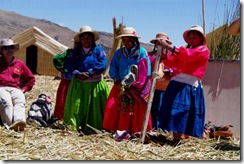Lake Titikaka is the highest navigable fresh water lake in the world at 3,800 metres. It covers approximately 8,300 square kilometres and is up to 280 metres deep. Sixty percent of the area is in Peru and the remainder belongs to Bolivia, who maintains perhaps the worlds smallest navy on the lake.
One of the unique features of the lake is the presence of over one hundred floating islands on which communities of five to twenty families live. These people have lived on these islands for generations.
The islands are made by cutting the roots of the massive reed beds from the shallow part of the lake into big cubes, drying them and tying them together as a foundation for an island. Reeds are then laid in cross ways layers until the island is half a metre or so above the water. The island is then anchored to the bed of the lake by rope.
It seems that these islands can last for up to twenty years before they start to sink and then a new island is made to replace it.
Families live in simple huts made out of reeds.
They are predominantly fishermen and trade their catch for other staples such as cereals and potatoes. Each island has a 5 square metre hole in the centre in which a net is established to create a fish farm for growing trout and kingfish. The island that we visited had five families (not necessarily related). A chief is elected annually (either a man or a woman)p with the only prerequisite being that they are married. Their language is a local Indian dialect.
Traditionally, their form of transport was in beautifully made reed boats. The design of these boats formed the basis of the design of the RA which Thor Heyerdahl aimed to travel across the pacific to prove the origin of South American people.









Thanks Bruce for such a great guided tour. Hope Jill has recovered and your loss of appetite is not permanent stay safe.Love Joy and Jim.